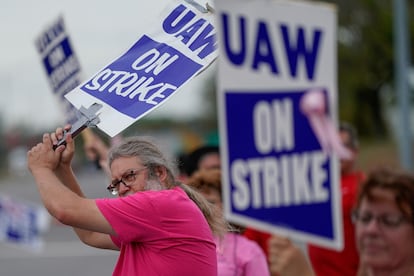US auto giants negotiate against the clock to prevent historic strike
United Auto Workers are threatening to stop work at General Motors, Ford and Stellantis if a new collective agreement is not reached


The United States is grappling with a wave of labor disputes. High inflation has distanced employers from unions in key sectors such as the auto sector, the industrial engine of a country where having a car is almost a necessity. The United Auto Workers (UAW) union is digging in its heels in as it negotiates a new collective agreement with the Detroit giants: General Motors, Ford and Stellantis. The UAW has threatened to go on strike on Friday if its demands are not met. It would be the first time in the union’s 80-plus-year history that it struck all three companies at the same time. The strike, however, would only target a small number of factories per company.
Given the rising tensions, the strike seems almost inevitable. “We do not yet have offers on the table that reflect the sacrifices and contributions our members have made to these companies,” said Shawn Fain, the leader of the UAW, which represents around 146,000 autoworkers at the three companies. “To win, we’re likely going to have to take action,” he added in an online address.
The UAW are demanding a 46% wage increase over four years (although it has shown signs of agreeing to a figure less than 40%), a 32-hour work week with 40 hours of pay; the reestablishment of traditional pensions with defined benefits for new hires and compensation for inflation. The union points out that its workers agreed to make sacrifices when companies were struggling in the wake of the financial crisis and recession. Now that the sector has bounced back, they want better conditions.
The UAW also wants the workers of the new electric battery plants — that are being built across the country thanks to the tax incentives for electric cars — to be able to join the UAW union and for the sector’s salary conditions to be applied to them.
The companies argue that they cannot afford to meet the unions’ demands unaffordable as they need to make large investments to design electric vehicles and build batteries and assembly plants for the future, while keeping current combustion car factories running. They argue that raising wages in line with the union’s demand would prevent American manufacturers from competing with those in other countries. Tesla, the leader in electric cars, is not affected by the possible strike, since its workers are not unionized.
The UAW union has a strike fund of $845 million to compensate employees who go on strike and stop receiving pay. With 146,000 workers in the affected companies, this fund would barely last three months, since the union pays $500 a week to those on strike, plus other costs. The unions are studying which factories to strategically target, for example engines and transmissions. The goal is to strangle the production chain of the companies’ most profitable models without requiring everyone to stop working.
Fain said on Wednesday that the final decision on which plants will go on strike will not be made until Thursday night and will be announced at 10:00 p.m., to keep the companies in suspense: “We will not strike all of our facilities at once,” he said.
Ford CEO Jim Farley said the company had made the “most generous offer” in its history to the UAW union early Tuesday. The offer increased wages by 14% in four years (which on Wednesday was raised to 20% in four and a half years), eliminated different salary levels for the same job, provided protection against inflation and included greater contributions to the pension plans. It, however, rejected the 32-hour, four-day week. “We’re absolutely ready for a strike and I know the UAW is too,” Farley told reporters in Detroit on Tuesday afternoon. “But we don’t want it.”
GM President Mark Reuss said Tuesday that a lot of progress had been made in recent days. “The give-and-take is really happening, so we’re on a path, that’s part of the process,” he said at a Detroit industry meeting organized by the trade publication Automotive News, in statements reported by AP. Reuss said GM’s goal is to reward employees while investing in the future. GM has offered a wage increase of 18% over four years and Stellantis, 17.5%, according to proposals updated on Wednesday.
Multimillion-dollar benefits
Shawn Fain — who has led the union since March, after winning the first elections with a direct vote of members — has adopted a combative tone from the start. He has described some of the manufacturers’ offers as “garbage” or an “insult.” And in his addresses, he has pointed out that the companies have made multimillion-dollar profits, while executives receive large salaries and incentives.
The gulf between the two sides means it is unlikely a deal will be struck before the Thursday midnight deadline. The automobile sector accounts for an important slice of Americas’s gross domestic product (GDP), but its impact is greater in the Midwestern states.
A strike in the sector would weigh down the U.S. economy at a time when interest rate spikes and higher prices due to inflation are taking their toll. For the U.S. President Joe Biden, who calls himself the most pro-union president in history, a strike would be more bad news.
Sign up for our weekly newsletter to get more English-language news coverage from EL PAÍS USA Edition
Tu suscripción se está usando en otro dispositivo
¿Quieres añadir otro usuario a tu suscripción?
Si continúas leyendo en este dispositivo, no se podrá leer en el otro.
FlechaTu suscripción se está usando en otro dispositivo y solo puedes acceder a EL PAÍS desde un dispositivo a la vez.
Si quieres compartir tu cuenta, cambia tu suscripción a la modalidad Premium, así podrás añadir otro usuario. Cada uno accederá con su propia cuenta de email, lo que os permitirá personalizar vuestra experiencia en EL PAÍS.
¿Tienes una suscripción de empresa? Accede aquí para contratar más cuentas.
En el caso de no saber quién está usando tu cuenta, te recomendamos cambiar tu contraseña aquí.
Si decides continuar compartiendo tu cuenta, este mensaje se mostrará en tu dispositivo y en el de la otra persona que está usando tu cuenta de forma indefinida, afectando a tu experiencia de lectura. Puedes consultar aquí los términos y condiciones de la suscripción digital.
More information
Archived In
Últimas noticias
Charles Dubouloz, mountaineering star, retires at 36 with a farewell tour inspired by Walter Bonatti
From the White House to diplomatic gifts: Lego wins over adult fans, brick by brick
Kate Winslet makes her directorial debut: ‘There aren’t more female directors because we’re busy raising children’
ChatGPT fails the test: This is how it endangers the lives of minors
Most viewed
- Families demand repatriation of bodies of Colombians who died in Ukraine: ‘This war is a slaughterhouse for foreigners’
- The low-cost creative revolution: How technology is making art accessible to everyone
- Liset Menéndez de la Prida, neuroscientist: ‘It’s not normal to constantly seek pleasure; it’s important to be bored, to be calm’
- Christian Louboutin: ‘Young people don’t want to be like their parents. And if their parents wear sneakers, they’re going to look for something else’
- ‘El Limones’ and the growing union disguise of Mexican organized crime










































